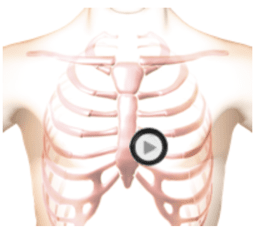This is an example of Tetralogy of Fallot heard at the tricuspid position.
Tetralogy of Fallot is a congenital condition often called Blue Baby Syndrome. It is characterized by four abnormalities:
- pulmonic stenosis
- increased thickening of the right ventricle
- a ventricular septal defect
- overriding aorta
The first and second heart sounds are normal and unsplit. There is an aortic ejection click in systole. There is a diamond shaped murmur following the click and ending well before the second heart sound.
In the anatomy video you can see turbulent flow from the right ventricle into the pulmonary artery across the stenotic pulmonic valve and turbulent flow from the left ventricle to the right ventricle (the ventricular septal defect). The right ventricular wall is thickened.
If you listen at the tricuspid position, you are hearing the ventricular septal defect. If you listen at the pulmonic area, you are hearing the pulmonic stenosis. Both create diamond shaped systolic murmurs.
Tetralogy of Fallot Audio


Technique

The patient's position should be supine.
Auscultation Tips for Tetralogy of Fallot
Systole:Aortic ejection click then a short diamond shaped murmurS2:May be partially masked by systolic murmur
Sound Wave
Tetralogy of Fallot Video
Observe turbulent flow from the right ventricle into the pulmonary artery across the stenotic pulmonic valve and turbulent flow from the left ventricle to the right ventricle (the ventricular septal defect). The right ventricular wall is thickened.
Authors and Sources
Authors and Reviewers
- ECG heart rhythm modules: Thomas O'Brien.
- ECG monitor simulation developer: Steve Collmann
-
12 Lead Course: Dr. Michael Mazzini, MD.
- Spanish language ECG: Breena R. Taira, MD, MPH
- Medical review: Dr. Jonathan Keroes, MD
- Medical review: Dr. Pedro Azevedo, MD, Cardiology
- Last Update: 11/8/2021
Sources
-
Electrocardiography for Healthcare Professionals, 6th Edition
Kathryn Booth and Thomas O'Brien
ISBN10: 1265013470, ISBN13: 9781265013479
McGraw Hill, 2023 -
Rapid Interpretation of EKG's, Sixth Edition
Dale Dublin
Cover Publishing Company -
EKG Reference Guide
EKG.Academy -
12 Lead EKG for Nurses: Simple Steps to Interpret Rhythms, Arrhythmias, Blocks, Hypertrophy, Infarcts, & Cardiac Drugs
Aaron Reed
Create Space Independent Publishing -
Heart Sounds and Murmurs: A Practical Guide with Audio CD-ROM 3rd Edition
Elsevier-Health Sciences Division
Barbara A. Erickson, PhD, RN, CCRN -
The Virtual Cardiac Patient: A Multimedia Guide to Heart Sounds, Murmurs, EKG
Jonathan Keroes, David Lieberman
Publisher: Lippincott Williams & Wilkin)
ISBN-10: 0781784425; ISBN-13: 978-0781784429 - Project Semilla, UCLA Emergency Medicine, EKG Training Breena R. Taira, MD, MPH
-
ECG Reference Guide
PracticalClinicalSkills.com
Tetralogy of Fallot | Auscultation Cheat Sheet with Sounds & Video | #112